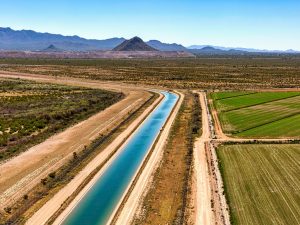Canal Irrigation
Canal irrigation with 3 types, advantage, disadvantage
It is the main waterway that brings irrigation water from a water source to the areas to be irrigated. Canal irrigation can be lined with a flexible, concrete, brick, stone, or membrane to prevent erosion and seepage.

A channel, or ditch, open canal, is an open waterway whose purpose is to carry water flow from one place to another place. canals and Channels refer to main waterways supplying water to one or more farms. Field ditches have conveyed water and smaller dimensions from the farm entrance to the irrigated fields.
Canal irrigation system
Much more challenging than that of groundwater is the improvement of the performance of canal irrigation, which will require the dominant water transfer technique in the future in developing countries. The standards used for the design of irrigation canals in many developed countries have not kept up with the development of new technologies. Most traditional canal irrigation delivery systems have no or little flexibility built into them.
Pure Water deliveries at farm level are not compatible with the key requirements of modern agriculture systems Thoughts on how to assess the performance of canal irrigation projects are evolving.
designing and even operating a canal irrigation system, The engineering concept of efficiency at different levels of a canal irrigation system is important for planning.

Then respond that water quality may decline in the recycling process, lands adjacent to canals may be affected by waterlogging and salinization, Advocates of water conservation measures, such as canal lining, and an important volume of water can be lost from the wasteland.
The application of water conservation measures in a positive impact on third parties or irrigation can have negative effects. Debate theory is endless.
Advantages of Canal Irrigation:
- Un-irrigated wastelands can be ready by canal irrigation. which would increase the quantity and quality of biomass in the area.
- avoiding dangerous droughts to Economic development can be expedited. Dependence on rainfall can be minimized through canal irrigation system development.
- Irrigation Canals are fed by rainwater received by rivers, the water is used for irrigation. Production of crops needing more water is also possible through irrigation canals. higher productivity per hectare is also possible due to canals, As compared to un-irrigated soils.
- The irrigation Canal system is a permanent structure, hence only maintenance is required for a long time benefit.
- Irrigation Canals are multi-purpose where apart from the drinking water supply, irrigation hydroelectricity generation, navigation and fishery development is also done.
- Groundwater level does not go down on the water table account of canal irrigation, but on the contrary water table level increases the underground water, which facilitates easy digging of wells.
- Irrigation Canals are also becoming a source of a tourist attraction these days.
Disadvantages of Canal Irrigation:
- Due to imbalance in the distribution of irrigation canal water, waterlogging in other areas is caused due to collection of water there and a situation of scarcity somewhere. It makes the soil unproductive as alkalis come to the surface level due to waterlogging and harmful underground salts and.
- Insects and worms on account of stationary water in canals and Many diseases are caused due to the spread of mosquitoes.
- crops are destroyed for want of water for irrigation, Due to shortage of water in inundation canals.
- Regular maintenance and repair of canals are not done, due to which sediments are collected resulting in a reduction of capacity of irrigation canals.
- Due to more economic investment, the irrigation canal is not practicable to provide canal irrigation to all villages. Construction of canals also takes more time.
- Several types of social evils are generated in canal areas. Sometimes, disputes about water distribution and resulting in throwing of dead bodies and murders by the bank of a canal.
Types of canal irrigation lining.
- Plain cement concrete lining PCC.
- Reinforced cement concrete lining RCC.
- Brick lining.
Uses and effects of canal irrigation.
Irregular supply of water through the rivers is then regulated by the construction of amp barrages and dams. Irrigation Canal system irrigates a vast area. Even the deserts have been made resultant. availability of cement reduces and Cheap labour the cost of canal construction. Huge quantities of water from amp melting of snow and Monsoon rainfall can be stored in reservoirs during.
Choice and selection of canal irrigation methods.
The type of canal irrigation system selected is an important economic decision on the country. Some types of pressurized systems have operating costs and high capital but may conserve water and utilize minimal labour. Canal irrigation system use tends toward high value cropping patterns. Other systems operate but have high labour requirements and are relatively less expensive to construct.

